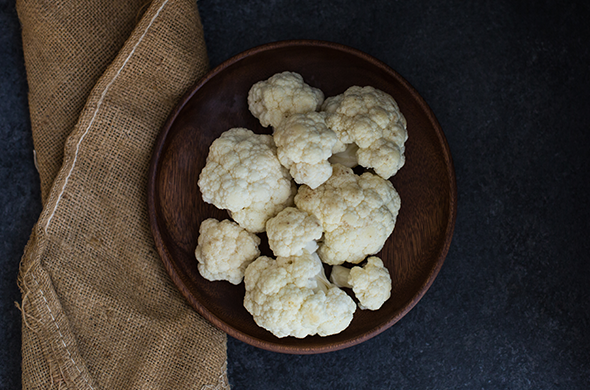“A cauliflower is nothing but a cabbage with a college education.” –Mark Twain
History
When it comes to cauliflower, there are two distinctly different opinions of this bountiful veggie: you’re either really for it or you’re really against it. Cabbage in latin means caulis (cabbage) and floris (flower), giving this basic veggie an elegant presence! Believed to have originated in ancient Asia and the Mediterranean, the oldest record of cauliflower dates back to the 6th century. It became popularized during the 16th century in France and England. It wasn’t until the 1920s that the cauliflower became commercially available in America.

Nutrition
One serving of chopped raw cauliflower (107g)
- Calories: 25
- Protein: 2.05g
- Carbs: 5.32g
- Sugars: 2.04g
- Calcium: 24mg
- Magnesium: 16mg
- Potassium, K: 320mg 9% DV
- Vitamin C: 51.6mg 86% DV
- Vitamin A: 13IU
- Vitamin K: 16.6µg 20% DV
- Water: 98.51g
- Fiber: 2.1g 8% DV
- Folate: 61 µg 15% DV
- Vitamin B6: .197µg 10% DV
Rich in Vitamin C & Vitamin K
Vitamin C, a golden superhero, is best known for its ability to help strengthen the immune system! This amazing vitamin plays an important role in producing collagen, which is crucial for teeth, bone, and tissue health. Vitamin C also has therapeutic properties that may reduce the severity of allergic reactions as well as fight off infections. Cauliflower also contains vitamin k which improves bone health by increasing bone density (the measurement of strength in bones). Because it strengthens bones, diets high in Vitamin K may lower rates of bone fractures.
High in Vitamin B6
Vitamin B6 helps make antibodies (warriors of health) which are needed to fight diseases and keeps blood sugar within normal ranges. This vitamin is key to healthy brain development, maintaining normal nerve function, and creating stable levels of serotonin.
High in Folate
Folate, aka vitamin B9, works with vitamin B6 to help break down carbohydrates into energy. That energy can help keep the liver, skin, and hair healthy.
A Flavorful Ingredient
Cauliflower can be eaten raw with your favorite dip as part of a vegetable tray or in a salad with your favorite kefir salad dressing. Cauliflower is also lovely baked, pan-fried, and roasted. It makes a low-carb pizza crust and even acts as a rice and potato substitute in many of your favorite recipes. We love steaming it and pureeing it in lighter soups, or blending it into smoothies for an added fiber and nutrient boost!